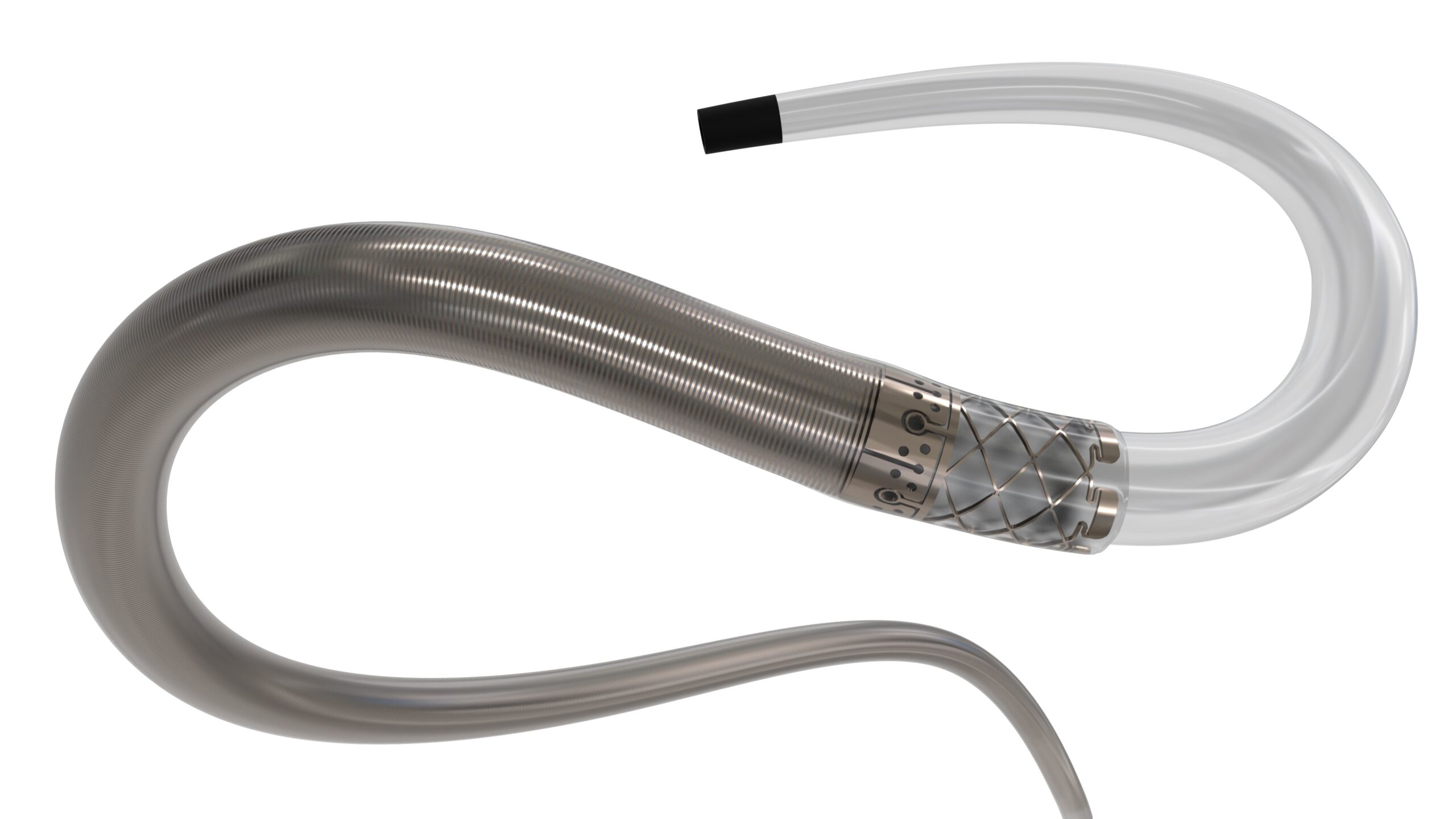This advertorial, intended for US readers only, is sponsored by Q’Apel Medical.

Hot on the heels of the device’s Food and Drug Administration (FDA) approval and subsequent US launch, Jan-Karl Burkhardt (Penn Medicine, Philadelphia, USA) and Omar Tanweer (Baylor College of Medicine, Houston, USA) discuss their experiences utilising the new-generation 072 Hippo aspiration system—and its Cheetah guiding companion—in the treatment of large vessel occlusion (LVO) acute ischaemic strokes.
“I would say this device is continuing the evolution of aspiration catheters, coming from round tips, larger tips and also bevel tips, to a more flexible tip,” Burkhardt says, alluding to the Hippo aspiration catheter’s unique engineering design.
“This may be one of the first times we’ve actually had an endovascular device or technology that is a little bit more personalised—something that’s not just ‘one size fits all’, which has usually been the approach,” Tanweer adds.
He goes on to note that many prior neurovascular catheters have effectively left physicians hoping to encounter “the right patient”, but that Hippo’s tip provides added flexibility to “suit the problem, or the pathology, that you’re treating”.
When these advantages are considered in conjunction with the visibility of the Hippo catheter on imaging, and the procedural efficiency enabled by its Cheetah companion, Q’Apel’s latest stroke technology represents an “exciting” advance in aspiration thrombectomy, according to Tanweer.
Initial experiences
Tanweer recalls having first heard about the device from a Q’Apel engineer, who said the company was planning to translate the innovative technology seen in its Walrus balloon-guide catheter (BGC) and other products into an aspiration catheter—“when I heard [this], I really pushed them for more details, because I was quite excited about what they had up their sleeve”, he notes.
Tanweer and Burkhardt were “lucky enough”, in the latter’s own words, to get their hands on this new technology at an early stage and become two of Hippo’s first US users following FDA approval of the device alongside Cheetah, which was announced in late 2023.
At Penn, Burkhardt and his colleagues began using ‘Hippo-Cheetah’ last October, and he has personally performed between 20 and 30 cases with the system already, while Tanweer’s team at Baylor have racked up around 40 cases since getting their hands on the technology in November.
“I was really, positively surprised from the beginning with how nicely the Hippo tracks up over the Cheetah—what I really like is that there’s no ‘step-off’ between the tracking device, the Cheetah, and the [Hippo] 072 system,” Burkhardt says.
“And, since I combine all my aspirations with a BGC, with Walrus, it is a really nice addition to the Walrus setup. It truly simplifies the procedure, for me, because you don’t need a microcatheter to use the device and—most of the time—you can avoid a wire as well. It speeds up the process, it’s less complex, and it’s very efficient.”
Broadly agreeing with all these points, Tanweer avers that Hippo brings with it a quick setup, ease of use, and flexibility, also noting that the option to swap out Cheetah for an alternative guiding device does exist, but he has never felt the need to because the Hippo-Cheetah system is “such a good marriage”.
“It’s been phenomenal,” he adds. “I’ve had similar experiences to Dr Burkhardt in terms of [advancing the catheter] without a wire. That is something I’ve never done before; a wire has always been part of my setup for stroke, but not having to use a wire— or at least having the freedom to use whatever type of wire you want—is fantastic.
“It leads to some cost-saving opportunities, it leads to simplicity, and it just leads to overall efficiency. As we know, ‘time is brain’, so the more time you save in preparation and in [deploying] the catheter, the better the outcomes are going to be.”
Features and benefits
Both Tanweer and Burkhardt place a great deal of emphasis on the benefits provided by the visible tip of the catheter, with Tanweer stating that this detail is a major part of the “game-changing technology” Q’Apel has introduced via its Hippo system.
The two are also in agreement regarding the benefits this feature can lead to—both relay that Hippo is well-suited to the vast majority of LVOs, including in the internal carotid artery (ICA), basilar artery, and M1 and large M2 segments of the middle cerebral artery (MCA), and is flexible enough to suit a range of clot sizes and compositions across all of these locations.
They are also in concurrence, however, that using the device is less appropriate in very distal occlusions within smaller vessels, primarily due to its relatively large, 0.072- inch diameter.

Tanweer goes on to highlight another of his favoured features of Hippo: its “very unique” visibility, which has allowed him and his colleagues to—again, for the first time—observe the actual engagement of the aspiration catheter’s tip with the surface of the clot on angiography imaging.
He clarifies that, previously, with other technologies, there has been an element of assuming the catheter tip is in contact with the clot, without being able to know for certain.
“And, because of the way it’s constructed, and that nice visibility, you’ll often see the tip compress, or come off at different angles,” he also states.
“In fact, we’ve been sharing some of the pictures, and we’re calling it ‘the many faces of Hippo’, as they all look very different [from case to case]. There are a lot of different configurations that you see once the catheter actually reaches the clot, so that’s been a huge benefit, and a reassurance that the catheter is where it needs to be.”
In addition, Tanweer reports—anecdotally, at least—being able to achieve a “really high” first-pass effect rate with Hippo, and believes it “probably performs better” than many older systems, but concedes that more rigorous research will be required to ascertain how the device truly compares to other aspiration catheters.
Burkhardt echoes this point, stating that his experiences have seen the device perform “really well”—both in terms of reaching and aspirating stroke-causing clots with a minimal number of passes—and that he hopes future studies or registries will provide more objective proof of its capabilities.
Q’Apel Medical
“With their great performing Walrus BGC, the unique SelectFlex technology in their Armadillo catheter, and now with Hippo and Cheetah, Q’Apel have demonstrated themselves to be craftsmen of catheters, and that can’t be said about a lot of other companies,” Tanweer comments.
“I enjoy seeing a product come out of Q’Apel and knowing that it’s focused well, and engineered well, and thought out from start to finish. That speaks volumes to how dedicated they are to catheter technology and stroke outcomes overall.”
Burkhardt’s feelings on the team behind the Hippo-Cheetah combination are similarly positive: he describes Q’Apel as a “problem-solving company”, and one that “sees what is needed, even if it’s not clear to everyone”.
Here, he cites the trackability of the Walrus BGC, and its compatibility with numerous other devices; the stability provided by SelectFlex technology; and, now, the aforementioned tip visibility benefits of the Hippo aspiration catheter.
“They have a lot of ideas, but they also follow them through with very good engineering and high-quality products,” Burkhardt avers.
“Hopefully, this will lead to a snowball effect, where people realise it’s not just one system for everyone—we have to address a huge variety of problems, from person to person, and pathology to pathology,” Tanweer concludes.
“I think [Q’Apel] have really opened up a new arena and have hopefully got people thinking about devices that can change from case to case. What they’ve done is impressive, and I really like the direction that this may take our catheters and implants in the future.”













